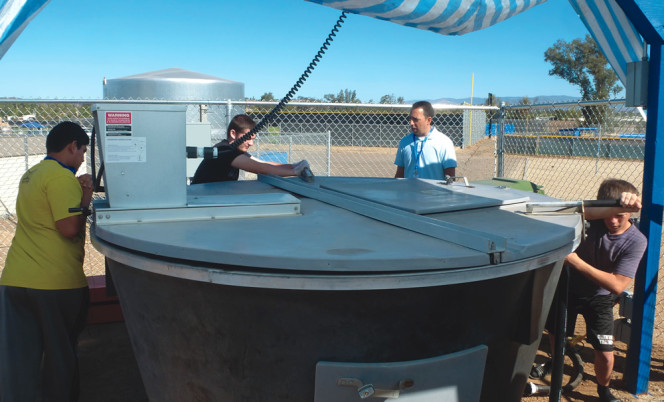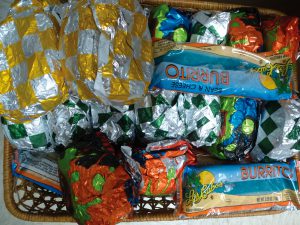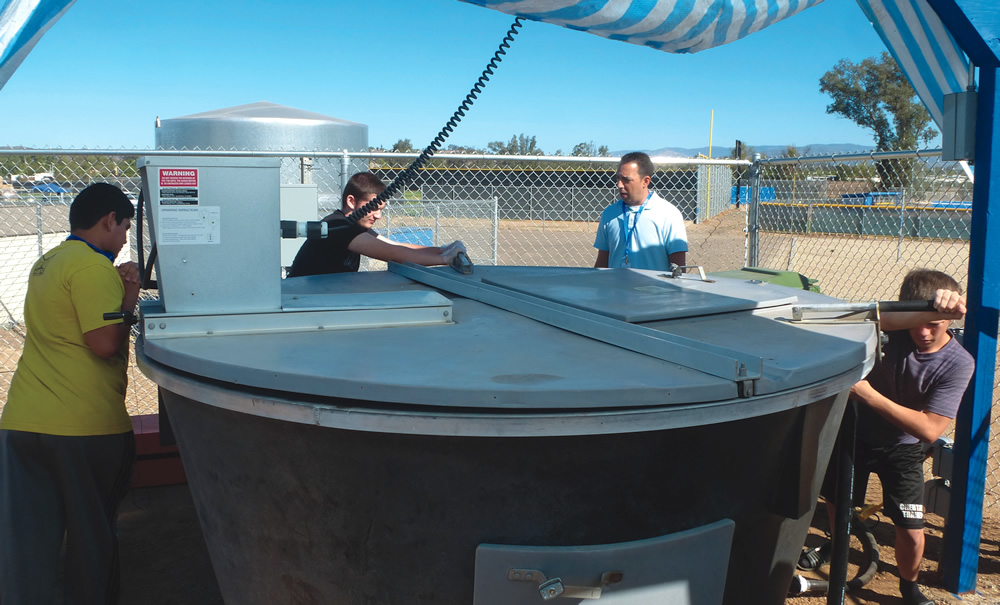Program servicing rural school district strengthens youth and the greater community’s understanding of the importance of food scrap diversion.
Rich Flammer
BioCycle March/April 2015

Composting of food scraps, green waste and tree trimmings is done on-site at Ramona High School in an Earth Tub unit. Student Eco-Leaders monitor the process, weighing and recording incoming feedstocks, taking temperatures and observing moisture levels. Photo by Rich Flammer
A partnership agreement formed in 2014 between the County of San Diego, California, and the Ramona Unified School District (Ramona USD) was the first step in the creation of a model waste reduction and sustainability program. The first of its kind and scale in southern California, the program employs state and nationally accepted hierarchies for reducing food waste, and includes source reduction methods, food donation, and food scrap diversion to animal feed, as well as onsite composting. “This is a fully closed loop model we’d like to duplicate throughout the county,” says Michael Wonsidler, Program Coordinator, with the County of San Diego Department of Public Works, Solid Waste Planning & Recycling Section.
Wonsidler has been the lead for the county facilitating this initiative and played a key role in its establishment. “Our partnership with Ramona Unified on this project has diverted a significant amount of food waste, and more importantly, strengthens youth and the greater community’s understanding of the importance of food scrap diversion, whether offering technical assistance to prevent food waste or encourage food donation, providing a supplemental source of animal feed, or allowing students to learn first hand about composting and its benefits to soils and gardens.”
Composting consultants under contract with the County conducted food scrap generation audits and developed the waste reduction and composting program in tandem with a very enthusiastic team of Ramona USD administrators and staff, including David Ostermann, Assistant Superintendent, Christopher King, Principal, Kati Harbour, Director of Food & Nutrition Services, Ed Anderson, Maintenance & Operations Supervisor, and Gloria Quinn, Specialized Academic Instructor. Ramona USD is a rural district in unincorporated San Diego County located approximately 25 miles northeast of metro San Diego. The district’s boundaries are approximately 150 square miles. The community of Ramona has a population of about 20,000, occupies approximately 38 square miles, and sits at an elevation of 1,430 feet in the Santa Maria Valley. With a Mediterranean climate, the average year round temperature is 62ºF and the area gets an average of about 16 inches of precipitation annually.
Program Cornerstones
Training and education are cornerstones of Ramona USD’s program, which is run by a spirited group of special needs high school students keen on sustainability and operating under the name “Eco-Leaders.” Composting began on September 9, 2014, and eight schools — with a combined enrollment of more than 5,400 students — have been diverting between 40 and 70 pounds of material a day. Unserved food or scraps are designated by kitchen staff as “donatable” for human consumption, suitable for livestock feed, or compostable in the district’s onsite unit.
Scraps for animal feed and composting are generated at all eight participating schools. Food suitable for donation is only generated at Ramona High School and the Oliver Pierce Middle School. These are the only two schools that serve wrapped burgers, burritos and sandwiches. Since they’re wrapped, there’s been no contact with student’s hands, so the nutrition director gave approval to donate them. Foods that were out in the open, like salad in a large serving tray or fruits, go to animal feed. A food delivery truck collects the food scraps at the end of each day and brings them to the high school, where they are stored in a walk-in cooler until the Eco-Leaders arrive the next day.
Food Donation: Food suitable for donation is placed in a walk-in freezer and collected weekly by a local pantry, the Ramona Food & Clothes Closet. This food is available to the underserved in the community, and also distributed to another organization that feeds the homeless.

Wrapped foods such as burgers, burritos and sandwiches are allowed to be donated as they have not been in contact with students’ hands. They are placed in a freezer and collected weekly by a local pantry. Photo by Rich Flammer
Animal Feed: Vegetative and bakery food scraps designated for animal feed go into specially marked three-gallon buckets with screw on lids, are put into a walk-in refrigerator, and delivered to Ramona High School Ag Department’s farm the next morning. Fruits, vegetables, bread and bakery wastes that have not come into contact with meat or dairy are the primary types of food sent to the farm, which has sheep, goats, cattle, pigs, chickens and ducks.
Composting: For onsite composting, the County purchased an Earth Tub manufactured by Green Mountain Technologies. The three-cubic yard unit, located at the high school, can handle all of the food scraps the district generates on a weekly basis, as well as a portion of its landscape and tree trimmings. Material that can’t be served to humans or animals goes into specially marked five-gallon buckets with screw on lids, also placed in the walk-in cooler, and collected by the Eco-Leaders the following morning for incorporation into the Earth Tub. Wood chips from onsite tree trimmings are utilized as a bulking agent, and the recipe mix is approximately 3:1 (bulking agent:food scraps) by volume. The compostingprocess is monitored by the students who weigh and record feedstock pounds collected, take temperatures, gauge moisture, and monitor odor and physical characteristics of the substrate.
All of this data is recorded using an iPad app and a form that was custom-designed by the County’s consultants for this project. After each morning’s monitoring, the data is sent electronically to consultants for review and incorporation into a master spreadsheet.
Finished product is used onsite as mulch and to amend the garden soil. The Eco-Leaders grow crops for sale to support their other programs.
Program Performance
Although only halfway through its first year, teacher and manager of the project, Gloria Quinn, recently was selected as “Teacher of the Year” by the local Veterans of Foreign Wars troop, with its commander praising her work “creating an inclusive environment, developing a garden program, and getting the food composter project started.” Future plans include selling the compost to provide additional program-supporting revenue.
Quinn is exceptionally pleased with how the project has evolved, and the wealth of hands-on experience and job skills it provides to her special needs students. She is particularly excited by the nature of the work involved with the composting, as it fulfills elements of all Career Ready Practices of the Common Career Technical Core (CCTC), “a state-led initiative to establish a set of rigorous, high quality standards for Career Technical Education.”
Implementation of the composting program has created a multitude of valuable learning opportunities such as monitoring and managing the microbial dynamics of the process, working with recipe mixes, weighing, characterizing and recording feedstocks, and exploring the relationship between resource management and community issues like food insecurity. Research has shown that experiential learning, such as the first hand nature of the work required by the Eco-Leaders, is one of the most effective ways to ensure students learn and retain new skills and information.
Rich Flammer of Hidden Resources, a BioCycle Contributing Editor, is a composting and zero waste consultant (www.compostingconsultant.com).













